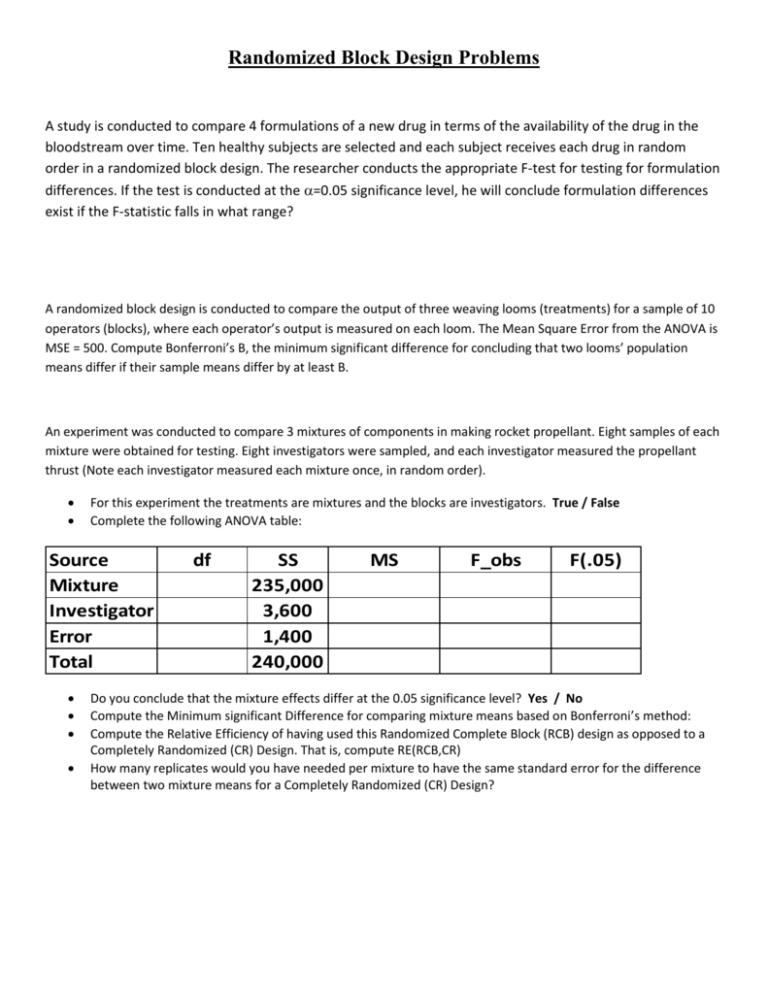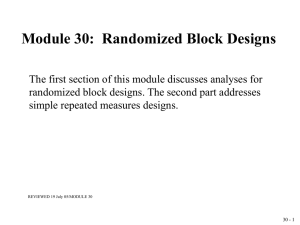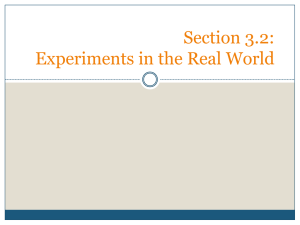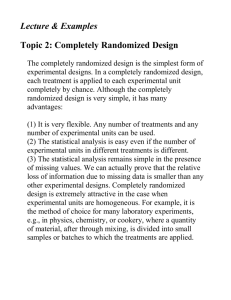Randomized Block Design Problems
advertisement

Randomized Block Design Problems A study is conducted to compare 4 formulations of a new drug in terms of the availability of the drug in the bloodstream over time. Ten healthy subjects are selected and each subject receives each drug in random order in a randomized block design. The researcher conducts the appropriate F-test for testing for formulation differences. If the test is conducted at the =0.05 significance level, he will conclude formulation differences exist if the F-statistic falls in what range? A randomized block design is conducted to compare the output of three weaving looms (treatments) for a sample of 10 operators (blocks), where each operator’s output is measured on each loom. The Mean Square Error from the ANOVA is MSE = 500. Compute Bonferroni’s B, the minimum significant difference for concluding that two looms’ population means differ if their sample means differ by at least B. An experiment was conducted to compare 3 mixtures of components in making rocket propellant. Eight samples of each mixture were obtained for testing. Eight investigators were sampled, and each investigator measured the propellant thrust (Note each investigator measured each mixture once, in random order). For this experiment the treatments are mixtures and the blocks are investigators. True / False Complete the following ANOVA table: Source Mixture Investigator Error Total df SS 235,000 3,600 1,400 240,000 MS F_obs F(.05) Do you conclude that the mixture effects differ at the 0.05 significance level? Yes / No Compute the Minimum significant Difference for comparing mixture means based on Bonferroni’s method: Compute the Relative Efficiency of having used this Randomized Complete Block (RCB) design as opposed to a Completely Randomized (CR) Design. That is, compute RE(RCB,CR) How many replicates would you have needed per mixture to have the same standard error for the difference between two mixture means for a Completely Randomized (CR) Design? Q.3. A college’s volleyball coach is interested in whether her team’s players prefer one brand of shoe among 3 brands. She has each player practice wearing each brand (in random order), and has each player rate the comfort on a 0-100 visual analogue scale. She analyzes the experiment as a Randomized Block Design with t = 3 treatments (shoe brands) and b = 18 (team players). She obtains the following results from the Analysis of Variance: Y 1 65 Y 2 80 Y 3 55 MSE 225 p.3.a. Use Bonferroni’s method to obtain simultaneous 95% confidence intervals for the population mean ratings differences among all pairs of brands. Bij = p.3.b. Show your results by drawing lines that join means that are not significantly different. 3 1 2 Q.8. An experiment is conducted as a Randomized Block Design, and you obtain the following partial Analysis of Variance Table. Source Treatments Blocks Error Total DF 5 6 SS 1500 3600 MS F 60 #N/A #N/A #N/A #N/A F(.05) Conclude Effects??? Yes / No #N/A #N/A #N/A #N/A #N/A #N/A p.8.a. Complete the table. p.8.b. Number of treatments = _____ p.8.c. Number of blocks = ____ p.8.d. Number of observations = ____ Q.9. A researcher reports the Relative Efficiency of a Randomized Block Design, relative to a Completely Randomized Design of 5. The Randomized Block Design had 5 treatments and 8 blocks. How many observations would be needed to have as precise of estimates of treatment means, if the experiment was conducted as to a Completely Randomized Design? p.9.a. observations per treatment = ________________ p.10.b. total number of observations _________ Q.10. Compute Bonferroni’s Minimum Significant Difference (Bij) for each of the following experiments (all with experimentwise error rate of 0.05): p.10.b. Randomized Block Design: t = 3 treatments, b = 11 blocks, MSE = 80 Q.5. An experiment is conducted as a Randomized Block Design, with 10 blocks and 5 treatments, reports a relative efficiency (relative to a Completely Randomized Design) of RE = 5. How many TOTAL subjects would be needed if we ran a CRD, to obtain the same standard error of a treatment mean? i) 50 ii) 10 iii) 25 iv) 250 v) 500 Q.8. A study was conducted to determine how consistent forensic examiners (“treatments”) are when determining the number of minutiae that appear on latent fingerprints (“blocks”). The study involve t = 10 examiners and b = 10 latent fingerprints. Each fingerprint was observed by each examiner. The means are given below, as well as some summary statistics. Means Fingerprint Examiner Y 12.7 1 20.6 10.2 2 13.4 11.3 Yij Y 10 10 i 1 j 1 10 (20.6 12.7) 2 3 20.1 11.8 2 4 9.8 13.5 5 10.7 11.3 6 8.4 12.9 7 12.1 13.6 8 15.6 11.3 9 7.1 17.4 3359 (9.1 12.7) 2 2016 10 (10.2 12.7) 2 (13.6 12.7) 2 373 p.8.a. Complete the following ANOVA table. Source df 10 9.1 13.6 SS MS F p.8.b. Compute Bonferroni’s Minimum significant difference for comparing all pairs of examiners. Q.4. A Randomized Block Design was conducted where 7 food items (treatments) by 103 evaluators (blocks) to determine whether there are any differences in true mean “liking scores” among the 7 food items. The model fit and null hypothesis are: Yij i j ij i 1,..., 7; j 1,...,103 H 0 : 1 ... 7 0 p.4.a. Complete the following ANOVA table: Source Treatments Blocks Error Total df SS MS 459 23136 2351 25946 F_obs #N/A #N/A #N/A #N/A F(0.05) #N/A #N/A #N/A p.4.b. Compute and interpret the relative efficiency of the Randomized Block to the Completely Randomized Design: Relative Efficiency : ___________________ # Raters per treatment needed for CRD: _________________ p.4.c. Compute Bonferroni’s minimum significant difference for comparing all pairs to food items. 2. A consumer is interested in comparing prices among 3 grocery store chains in his city. He randomly samples 8 branded products and obtains the regular price of each product at each store. He finds that between store variation accounts for 20% of the total variation and between product variation accounts for 60% of the total variation. (a) Complete the following ANOVA table. Source DF SS 24-1=23 600 MS Fobs Stores Products Error Total (b) Test whether we can conclude that the population mean prices differ among the three stores by completing the following sentence (use =0.05 significance level and circle any correct bold type options and fill appropriate numeric values in the blanks). Conclude / Do Not conclude means differ since ____ is above / below ________ (c) This is an example of dependent samples because (circle the best answer): i. The sample sizes for each store are the same ii. The same products are observed at each store iii. There are 3 stores 3. A Randomized Block Design is used to compare 3 types of sounds on sleep in 9 people suffering from sleeping disorders. Each subject is assigned to each sound type (in random order) and the time until the person falls asleep is measured The following calculations are obtained from a statistical software program. x1 40 x 2 60 x 3 50 MSE 112.5 Use Bonferroni’s method to obtain simultaneous 95% confidence intervals for all pairs of population means. Give the correct conclusion based on the intervals (NSD=”Not significantly different). Sounds Point Estimate Confidence Interval Conclude 1 vs 2 1 vs 3 2 vs 3 Q.1. A Randomized Complete Block Design was conducted to compare 3 energy drinks in terms of endurance in 6 subjects (each subject drinks each energy drink). The response is time to exhaustion on a treadmill. Due to some outlying observations, use Friedman’s test to determine whether the 3 energy drinks differ in their effects on endurance. Subject 1 2 3 4 5 6 Drink1 42 36 54 44 28 45 Drink2 48 34 56 46 32 50 Drink3 62 48 75 52 44 65 p.1.a. Compute the test statistic. Test Statistic = ________________________________________ p.1.b. Give the Rejection Region ________________________________





